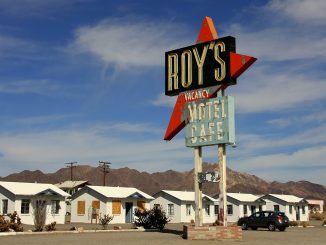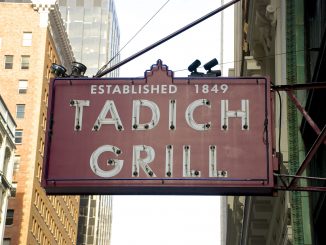
The Modesto Arch, built in 1912 to welcome automobiles to Modesto, California, currently stands at the intersection of 9th and I Streets. A tribute to the greatness and potential of the city for more than a hundred years, the arch has become a roadside attraction and popular backdrop for photos and TV news. Flanked by two Mediterranean cypress trees, the blue metal arch bears the city’s motto, “Water, Wealth, Contentment, Health”. A tribute to Stanislaus County and the waters of the Sierras that irrigate the rich land.
In May, 1911, Modesto businessmen formed an official committee to institute an idea that had been floated for a while that beautifying Modesto would add elegance to the city as well as benefiting tourism of the then bustling downtown. At their May meeting, the businessmen were unhappy with the proposals they had been shown and by August had decided to offer a fifty dollar prize for “the best design or arch over I Street near the depot”.
The businessmen’s association finally decided on a grand design by Bernard J. Joseph of San Francisco, considered to be one of California’s finest architects at the time. That the famous architect submitted a design at all was a sign to the city that they were indeed a city on the rise.
Joseph’s assistant, Clarence Dakin, once described the arch and its construction by saying, “We purposely made this arch elaborate. We believed that Modesto should have something that any city might be proud of. Paris itself would not sneer at an arch such as this. You intend to place the word ‘wealth’ on the arch. Therefore you do not want something that looks like it cost a nickel.”
Christened on March 9, 1912 with a bottle of canal water, the seventy-five foot wide steel arch rests on two twelve foot tall solid granite pillars. Reaching a center height of twenty-five feet, the arch was large enough to last the ages without being heavily modified for increased traffic. Due largely to a solid design and an eye on the future, the arch is essentially unchanged since 1912 and has only a few minor alterations. In 1934, the Modesto Arch was moved a few feet to allow for widening of 9th street. There was also a non-illuminated “welcome” sign that used to hang below the arch that was removed because it was just a tiny bit too low as delivery trucks became larger.
In 2012, a restoration project to restore the arch to its original glory was undertake. During the restoration the light bulbs were replaced with LED, the arch was repainted to the original color, minor cracks in the columns were patched, and the long since missing flagpoles were replaced.
Modesto is not a city known for their nostalgia or preservation of historic landmarks. They have since the first day of their incorporation always had an eye on the future and what their city could become. That desire to become a better place to live, a place constantly ready for the next chapter, makes it all the more special that they have found a place in their hearts to save the historic arch.
Modesto Arch Facts
- The original flagpoles on each of its columns were removed at some point due to rot but were replaced during the 2012 renovation.
- The sign almost said “Nobody’s Got Modesto’s Goat”, which won first place in a slogan contest.
- The estimated cost for construction of the arch in 1912 is $1,200.
- Eleanor McClatchy, publisher of The Modesto Bee, disliked the arch so much that she banned its picture from being used in the newspaper.
- The letters of the arch were originally illuminated by 696 incandescent light bulbs.
- The light bulbs were replaced with LEDs in 2012.
- The 1913 Panama Pacific Road Race, a 444 mile race from Los Angeles to Sacramento included a speedy drive under the Modesto Arch. The race that year was won by Frank Verbeck in his trusty Fiat.
- Modesto Arch Architect Bernard J. Joseph also designed the Hotel Hughson, a building so grand it was often considered the shining diamond in the crown of downtown Modesto. The Hotel Hughson has of course since been demolished.


